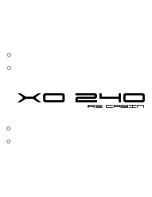
O
PERATING
AND
M
ANEUVERING
S
ECTION
6
4627 10/02
6.2.5 Shallow Water Operation
Always pay attention to the depth of the waters in which you are cruising.
Do not venture into waters which are too shallow for your boat’s draft.
Shallow water navigation can be very hazardous. If you do find yourself in
shallow waters, reduce speed immediately. Consult nautical charts to
determine your position. Try to plot a course out of the shallows through
waters deep enough for your boat’s draft. If your boat runs aground, radio
for help and wait until it arrives. Do not attempt to relaunch your boat. You
may do serious damage to your hull or underwater gear.
6.3 Controlling the Boat
Every boat owner should know how to perform the following procedures
competently. Do not attempt any of these procedures without first receiving
appropriate training.
6.3.1 Loading
When you load items onto the boat, have someone on the pier hand them to
you after you have boarded the boat. Stow all items securely to prevent
them from shifting when the boat is in motion. If your boat is loaded near
capacity or if seas get rough, distribute the weight evenly and keep the load
low. Don’t make any abrupt changes in its distribution. Shift the load or
move about only after stopping or slowing the boat.
6.3.2 Casting Off and Docking
Docking and casting off can be hampered by wind and current. It is impor-
tant to use the current by approaching or leaving with the current instead
of fighting against it. Also, the operator should adequately fender his boat
against collisions with docks or other boats.
6.3.2.1 Leaving a Pier or Mooring
Getting underway from a pier is normally accomplished by taking in all
lines except the bow spring. With a neutral rudder, power the boat forward
using only the engine farthest from the pier. The boat will pivot around the
bow spring line, moving the stern out and away from the pier. A fender
should be placed between the bow and the pier to prevent scraping as the
boat pivots about the bow spring. Once the stern is clear of boats and other
obstructions, take the bow spring in and back the boat away.
At marina anchorages, boats are often secured to a mooring buoy. Fouling
your propeller with a mooring line is the principal hazard when leaving a
mooring. If you use a dinghy to reach your boat, make sure the dinghy line
does not foul the propeller.
After getting onboard, start the engines and send someone forward to
slacken the line. Release the line. In a river with current, the boat will gain
Summary of Contents for 46 VOYAGER
Page 1: ...46 Voyager Owner s Guide HIN CDR 2005 Version 1...
Page 2: ......
Page 4: ......
Page 18: ......
Page 50: ...DC ELECTRICAL SYSTEM SECTION 2 4627 5 04 C4078B DC CONTROL CENTER C4046B UP...
Page 61: ...SECTION 2 DC ELECTRICAL SYSTEM 4627 5 04 2 5 DC Wiring Schematic C4081D 1...
Page 62: ...DC ELECTRICAL SYSTEM SECTION 2 4627 5 04 C4081D 2...
Page 87: ...SECTION 3 AC ELECTRICAL SYSTEM 4627 5 04 C4079D 2...
Page 88: ...AC ELECTRICAL SYSTEM SECTION 3 4627 5 04 C4080D 1 3 8 2 220V 50Hz Europe Australia...
Page 89: ...SECTION 3 AC ELECTRICAL SYSTEM 4627 5 04 C4080D 2...
Page 90: ...AC ELECTRICAL SYSTEM SECTION 3 4627 5 04...
Page 124: ...PROPULSION SECTION 5 4627 10 02...
Page 136: ...OPERATING AND MANEUVERING SECTION 6 4627 10 02...
Page 167: ......
















































